With so many suitcase sizes out there, it can be a daunting task to understand which is the best cabin luggage or suitcase for your needs. Do you need a large suitcase or a small suitcase? What is the best size and why? How many clothes can I fit in which suitcase? Do you need to purchase hard shell luggage or lightweight carry-on luggage only?
In this article, I will explain the suitcase sizes and help you understand what type of luggage you need and for what purpose. The perfect suitcase size depends on where you are travelling, for how long and which airline you are travelling with.
I have been travelling professionally for over 10 years and know how difficult it is to find the right suitcase. I will share my experience of how I pick my luggage before a trip. Let’s dig in and find the most suitable suitcase size for you.
Table of Contents
- Which size to pick?
- Standard Suitcase Sizes
- Cabin Suitcase Types & Sizes
- Small Cabin Suitcase (Carry-on)
- Small cabin suitcase size-guide:
- Large & Extra Large Cabin Suitcases
- Large cabin suitcase size-guide:
- XL cabin suitcase size-guide:
- Checked Luggage Types & Sizes
- Medium Suitcase Size
- Medium suitcase size-guide:
- Large & Extra Large Suitcase Sizes
- Large suitcase size-guide:
- Extra large suitcase size-guide:
- How to measure suitcase sizes?
- How to measure the outside of the suitcase:
- How to measure the inside of the suitcase (volume):
- What is the difference between volume and capacity?
- Suitcases based on travel style
- Budget Travellers
- Couples Trip & City Breaks
- Holidays (up to 2 weeks)
- Long-term Travels & Couples
- Families Travelling with children
- Suitcases or bags for Digital Nomads
- Carry-ons for Business Travellers
- Compare Carry-on Suitcase Sizes & Volumes
- Carry-on Suitcase Sizes chart for each Airline
- Size A – Carry-on suitcase
- Size B – Hand luggage
- Size C – Carry-on
- Size D – hand luggage
- Size E – carry on luggage
- Size F – Other Sizes
- Compare Checked-in Suitcase Sizes
- How much does extra baggage cost?
- Tips & Trick I learnt during our travels
- Always go for the four-wheel suitcases
- Less is more
- Carry your valuables with you at all times
- Hardshell vs soft case
- Travelling with batteries & drones
- Did I forget anything?
- Frequently Asked Questions
Which size to pick?
A wide variety of suitcases are available on the market, each catering to different travel needs and preferences. When selecting a suitcase, the key factor to consider is its size, ensuring it suits your travel requirements. The range of sizes available, from the smallest to the largest, includes:
Laptop bags, backpacks, duffle bags, carry-ons ranging from small to medium, and suitcases varying from small to large.

Standard Suitcase Sizes
These are the most common cabin (checked-in) or carry-on suitcase sizes:
| Size | Height/Width/Depth | Capacity | Travel Time |
|---|---|---|---|
| Small Cabin Suitcase | 45x32x18 cm (18x13x7 inches) | 30-40l | 1-2 days |
| Large Cabin Suitcase | 50×36.5×23.4 cm (20×14.4×9.2 inches) | 40-45l | 2-3 days |
| X-large Cabin Suitcase | 56x38x24.5 cm (22x15x9.5 inches) | 40-50l | 2-4 days |
These are the most common suitcase sizes:
| Size | Height/Width/Depth | Capacity | Travel Time |
|---|---|---|---|
| Small Suitcase | 57x39x22 cm (22.4×15.4×8.7 inches) | 50-60l | 3-4 days |
| Medium Suitcase | 60x43x26 cm (24x17x10.5 inches) | 60-75l | 4-7 days |
| Large Suitcase | 69x47x35.5 cm (27×18.5×14 inches) | 100-117l | 7-10 days |
| X-Large Suitcase | 81×55.8×35.5 cm (32x22x14 inches) | 120-130l | 7-14 days |
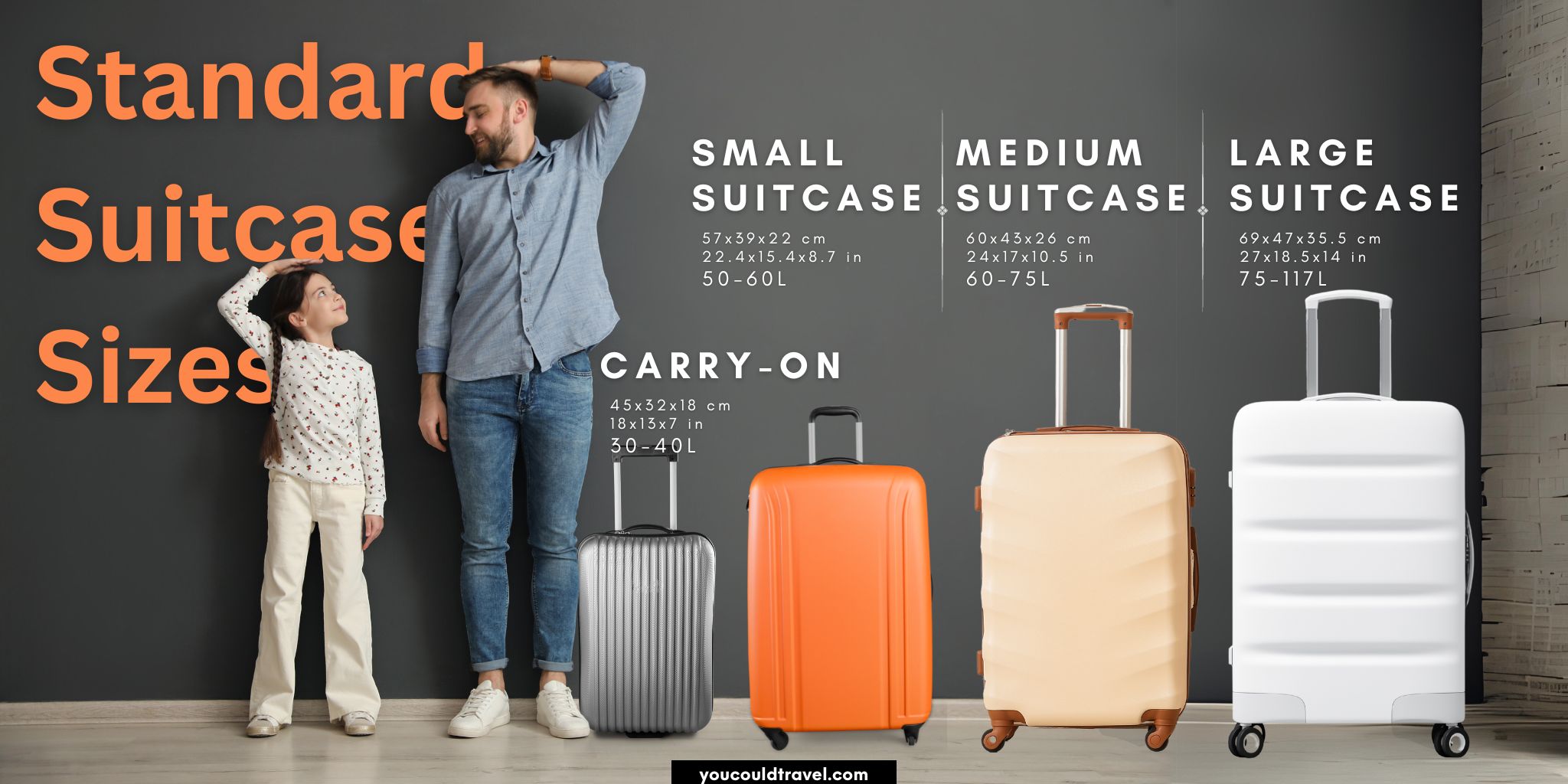
When looking for suitcases online or in the shop, have this chart with you. Remember to check the exact sizes of the suitcase to ensure they fit the airline allowance as well as the internal capacity (volume).

🧳A few tips to help you pick:
- Hard shell luggage will usually be smaller in capacity than a soft-sided suitcase, even if their volume is the same. This is because when you pack a soft shell suitcase, it can expand a little, accommodating more of your clothes.
- A four-wheel spinner also has a little smaller capacity than a two-wheel suitcase, but its overall size is often a bit bigger. That’s because the size of the suitcase is measured from the ground and includes the wheels. On two-wheel suitcases, the wheels are typically recessed, while the four-wheel spinners have their wheels fully out.
- And finally, please remember when you buy suitcases online to check the weight of the suitcase. Ideally, you want a lightweight suitcase, especially if you are buying a large or extra-large one. These will be difficult to carry when full, so best to look for the lightest ones.
Cabin Suitcase Types & Sizes
Shorter trips require a smaller suitcase. If you travel for 4 or fewer days, I recommend only taking a cabin bag with you. This is a lot more convenient than checked luggage for several reasons:
- Lightweight, easy to carry, free to take on board
- Online check-in, don’t have to queue to drop off luggage
- Leave the airport fast, don’t have to wait at the airport to pick up your luggage
The downside of a carry on is that you have less space and can’t take liquids with you on board (see airport restrictions on liquids).
Small Cabin Suitcase (Carry-on)
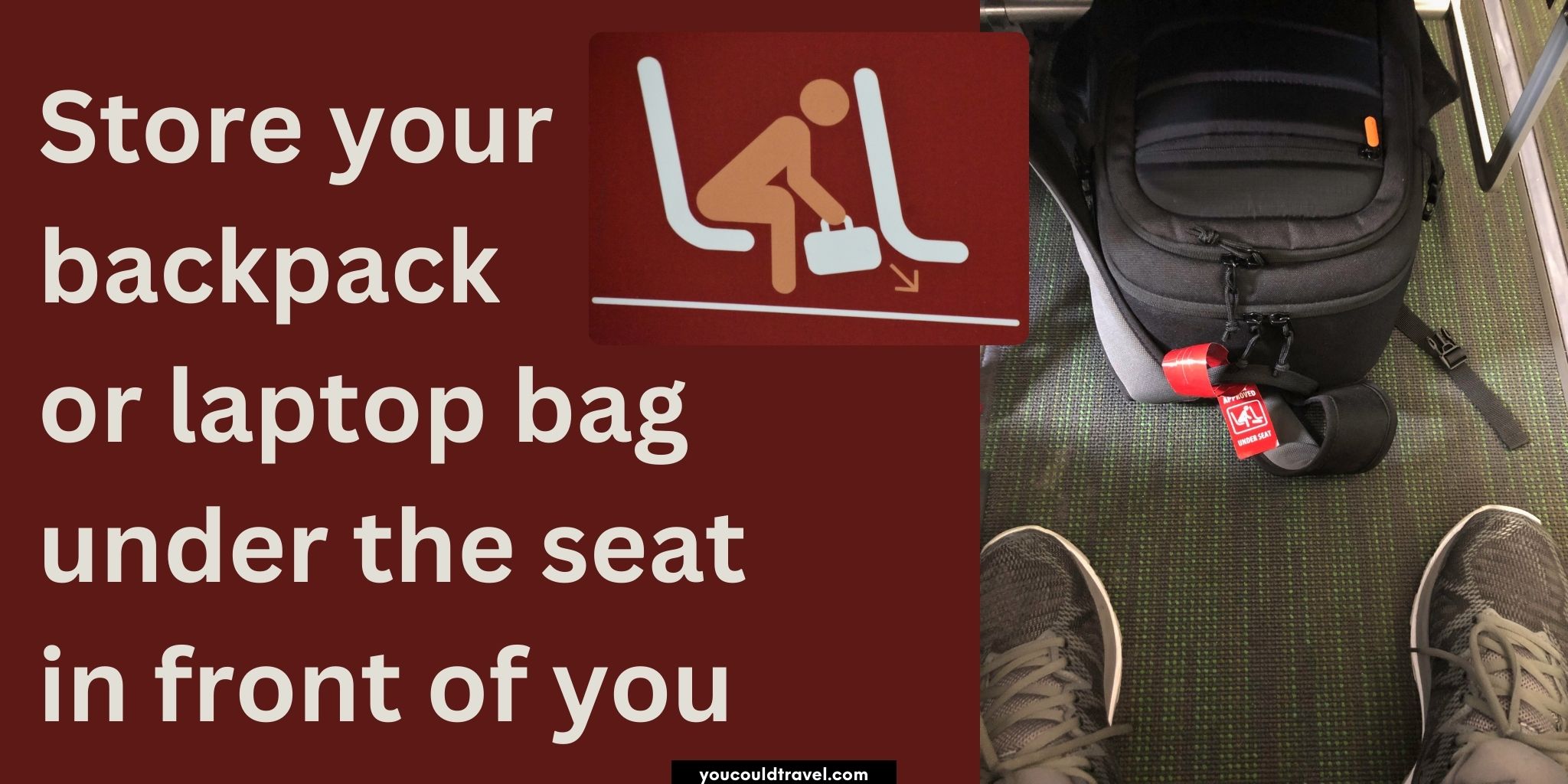
A small cabin suitcase, also called the hand luggage or carry-on. Use it on pretty much any airline, as you are allowed to take it onboard at no extra cost.
Small cabin suitcase size-guide:
- Height: 48 cm / 18 inches
- Standard size: 45x32x18cm (18x13x7inch)
- Capacity: maximum 40 litres
- Length of travel: 1-2 days
Why buy a hand luggage? The smallest of the suitcase sizes, the small cabin bag – no wheels (or one with wheels) is perfect for business travellers who only need their laptop and a few essentials with them. Because of the high luggage fees, carry-ons got popular.
Companies are making carry-ons designed to be as space efficient and easy to use, so you can get more of your things on board. Carry-ons are also great for travellers who have a large checked-in luggage and don’t want to carry anything else but their papers, electronics, and valuables on board.
Why not buy? Cabin suitcases are not recommended on their own for long trips due to their small size and lack of space.
Large & Extra Large Cabin Suitcases
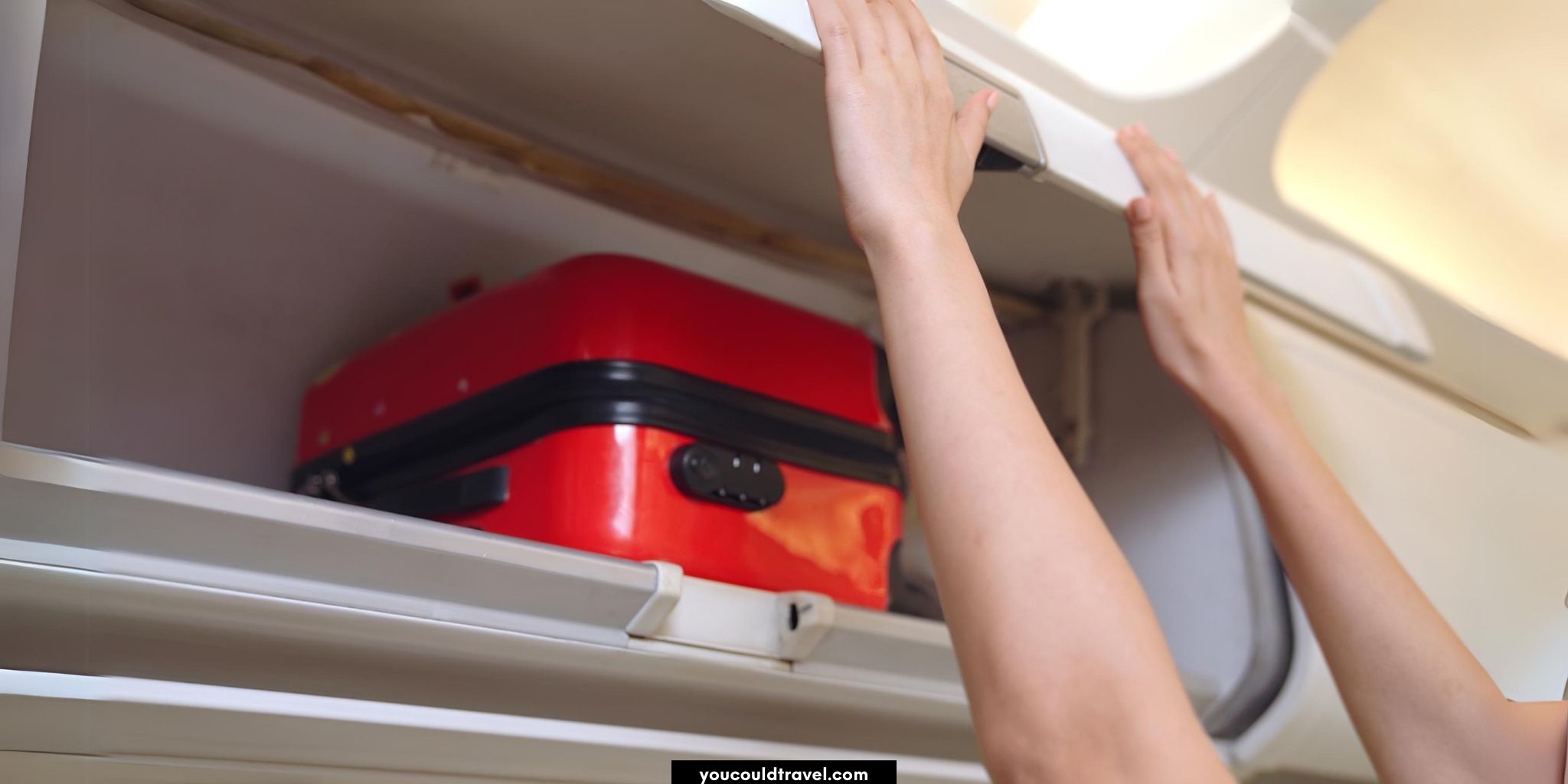
The large cabin suitcase (cabin bag) is perfect for short-haul flights, trips which last only a few days.
Large cabin suitcase size-guide:
- Height: 55 cm / 20 inches
- Standard size: 50x36x23cm (20×14.4×9.2inch)
- Capacity: maximum 45 litres
- Length of travel: 2-3 days
An extra-large cabin suitcase is around 56 cm or 22 inches in height, with a capacity of up to 50 litres. It is more spacious than the standard large cabin suitcase, adding an extra 5 litres in capacity.
XL cabin suitcase size-guide:
- Height: 56 cm / 22 inches
- Standard size: 56x38x24cm (22x15x9.5inch)
- Capacity: maximum 50 litres
- Length of travel: 2-3 days
If you are looking for standard-sized cabin luggage, the hard-case Large Cabin Suitcase is your best option.
It’s also ideal for budget travellers, travelling on low-cost flights, who purchased checked-in luggage or priority boarding. Most airlines accept 55 cm (20 inches) cabin suitcases. (See tables below for individual airlines carry-on allowances.)
Why buy this? Large cabin suitcases are perfect for city breaks or long weekend trips. The large cabin suitcase with four wheels is also great for short-haul flights.
Why not buy? Large cabin suitcases are pretty good if you travel short-haul for only 2-3 days. You will likely need a Medium Suitcase for holidays longer than 1 week.
Checked Luggage Types & Sizes
Medium Suitcase Size
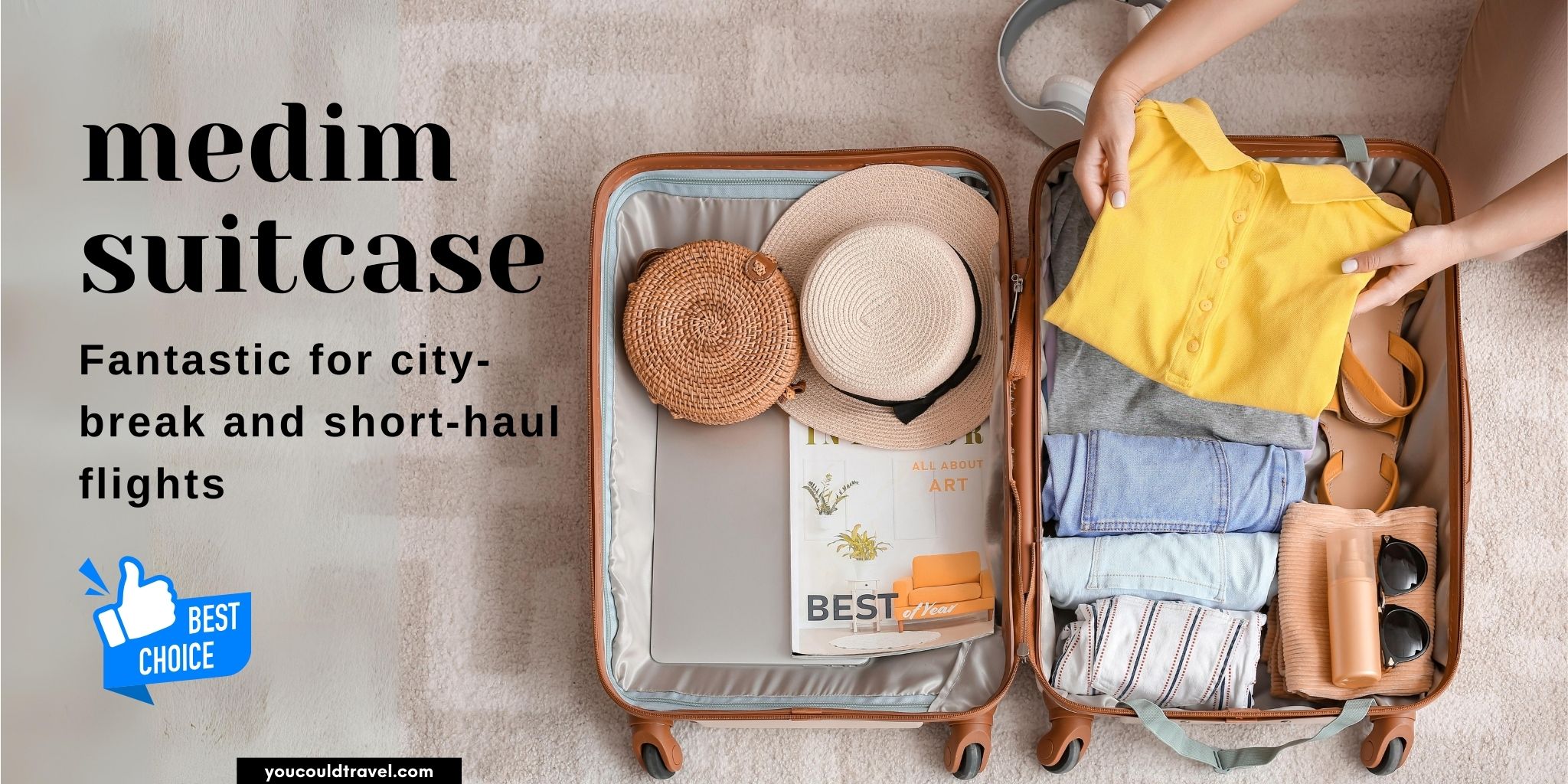
A medium suitcase measures 68 cm or 24 inches in height and has a capacity of up to 75 litres. This is a fantastic option to check in on short-haul flights alongside your carry-on.
Medium suitcase size-guide:
- Height: 68 cm / 24 inches
- Standard size: 60x43x26cm (24x17x10.5 inches)
- Capacity: maximum 75 litres
- Length of travel: 4-7 days
Medium Size Suitcases are great for short multi-city stops as it’s relatively lightweight and small enough to be practical to carry around with you. It usually fits comfortably into a taxi, and it’s not too much hassle to carry on public transport.
It’s my favourite suitcase because it’s versatile and easy to carry. It fits in the overhead luggage rack on trains and is simple to manoeuvre in cities.
Why buy this? If you want to check in your luggage, but it has to be small, so you can freely move around during your travels. Have a look at the four-wheel, spinner suitcases for additional convenience. These are easy to roll around and won’t fall over all the time.
Why not buy? I can’t find any fault with this size. Consider how much stuff you need and if you think it will fit, go for it. Medium Size Suitcases are typically large enough to fit clothes for about 7 days.
Large & Extra Large Suitcase Sizes
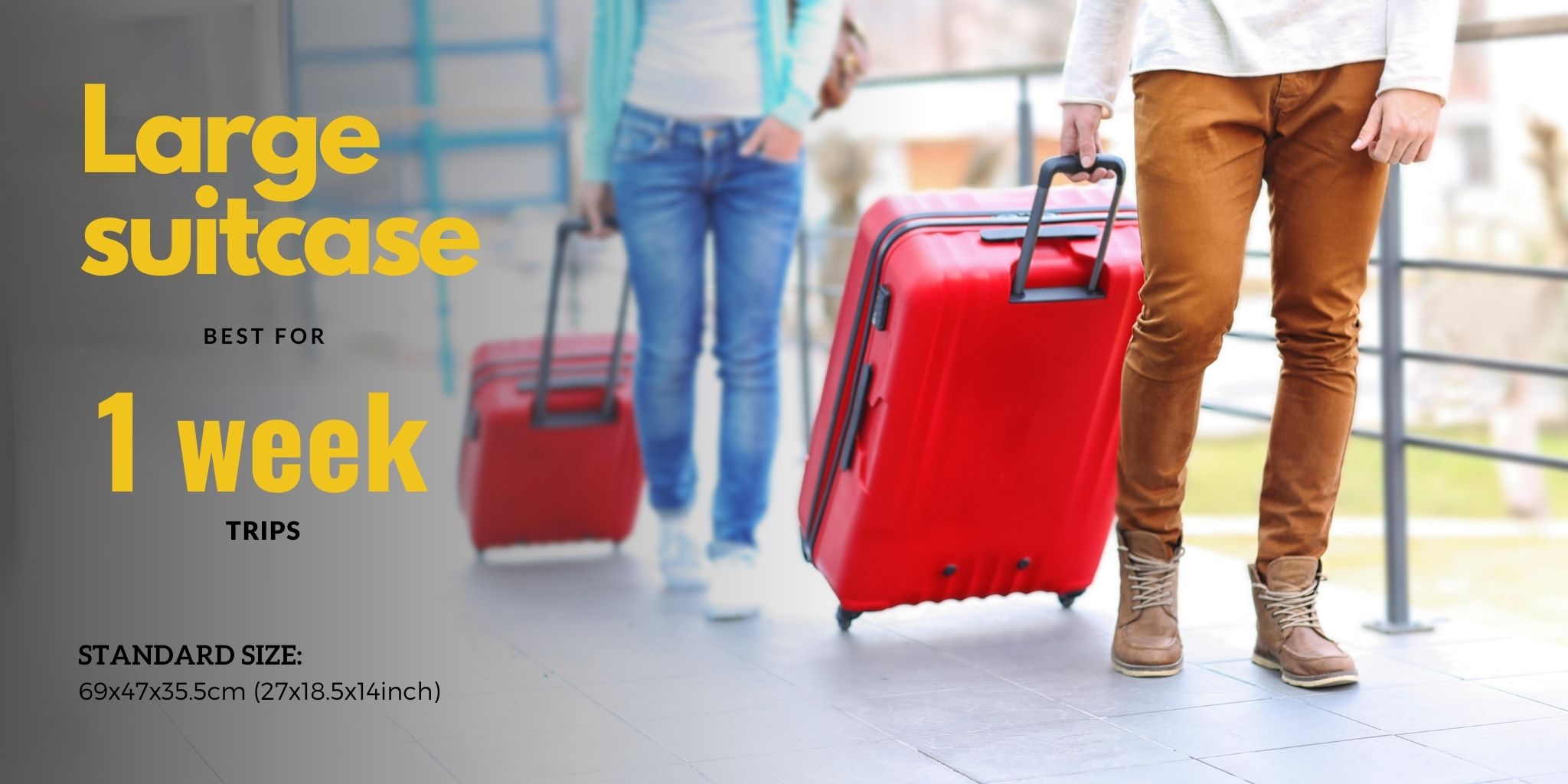
Out of all the suitcase sizes out there, large suitcases are perhaps the most popular for travellers wishing to check in their luggage. These suitcases are versatile, spacious and allow you to have a series of outfits with you. The large size gives you the freedom to pack whatever you need for your travels which last longer than 1 week.
Large suitcase size-guide:
- Height: 74 cm / 27 inches
- Standard size: 69x47x35.5cm (27×18.5x14inch).
- Capacity: maximum 117 litres
- Length of travel: 7-10 days
For long-term travel, longer than 2 weeks, we used these extra-large suitcases. Probably one of the best investments to date, I can highly recommend them. These bags made it with us to New Zealand, Japan, Canada and more.
Extra large suitcase size-guide:
- Height: 85 cm / 32 inches
- Standard size: 81×55.8×35.5 (32x22x14 inches)
- Capacity: maximum 130 litres
- Length of travel: 10-14+ days
Important: Airlines usually have a maximum limit of 35 kg for each checked luggage
Why buy this? The large suitcase is ideal for long trips, especially if you need to pack for more than one traveller. I recommend you to buy the large, four-wheel spinner version (28 inch) as it will be easier to roll it around.
Why not buy? This size can be too big for some. Check the amount of stuff you want to take with you and based on the length of your stay ask yourself. Do I really need this size?
My advice is to always check the checked baggage weight allowance for your flight. These suitcases are easy to overfill, and they can become too heavy. A good rule of thumb is to aim for no more than 20 kg (44 lb) weight per suitcase.
How to measure suitcase sizes?
I find that the best to get this out of the way first. You only measure suitcases one way – the way the airline will measure it.

How to measure the outside of the suitcase:
- Find a measuring tape.
- Place the suitcase on the floor.
- Measure the height of the suitcase from the ground to the top of the carry handle.
- The length of the luggage measured at its largest points, including wheels, pockets.
- The width is measured at the widest part of the suitcase, include wheels and pockets.
- Don’t include the pull-out handle when you measure your suitcase.
Remember, the measurements which come with the suitcase are always the external dimensions. Manufacturers won’t always give you the internal measurements of the suitcase.
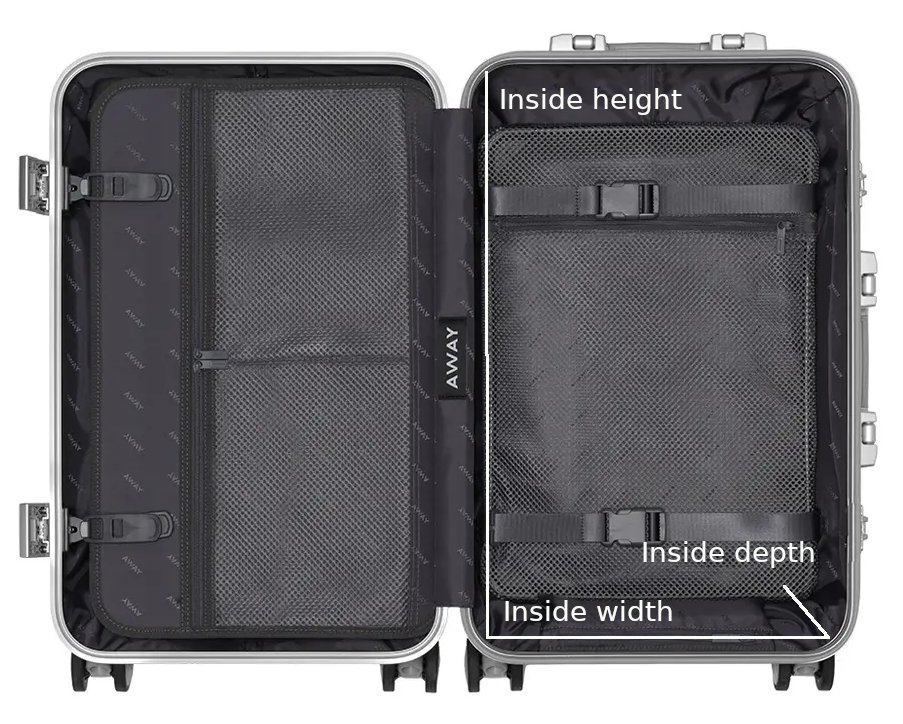
How to measure the inside of the suitcase (volume):
- Get a measuring tape.
- Place the suitcase on the floor, fully open.
- Measure the height of the suitcase from edge to edge.
- The width is measured at the widest part, edge to edge.
- The depth of the luggage is measured from the rim to the cover.
- Measure both sides, as the top is usually smaller.
Now, to get the volume of the suitcase (internal capacity) multiply the values you measured for the sides of the suitcase and add up the results. The result is the volume of the suitcase.
Height x Length x Depth = Volume (top)
Height x Length x Depth = Volume (base)
Volume (top) + Volume (base) = Suitcase Volume
What is the difference between volume and capacity?
These terms are the similar. We often use ‘volume’ to refer to the amount of space in a suitcase, and ‘capacity’ to describe how much stuff can actually fit inside it.
Capacity > Volume
Suitcases based on travel style
I have created a useful list of traveller types and what suitcases I recommend for them and why.
With so many suitcase sizes available on the market, it is important to first check the airline’s luggage policy and baggage weight allowance. Check your ticket; it normally shows the types of bags you can take on board, those you need to check in, and the weight limits for each.
Budget Travellers
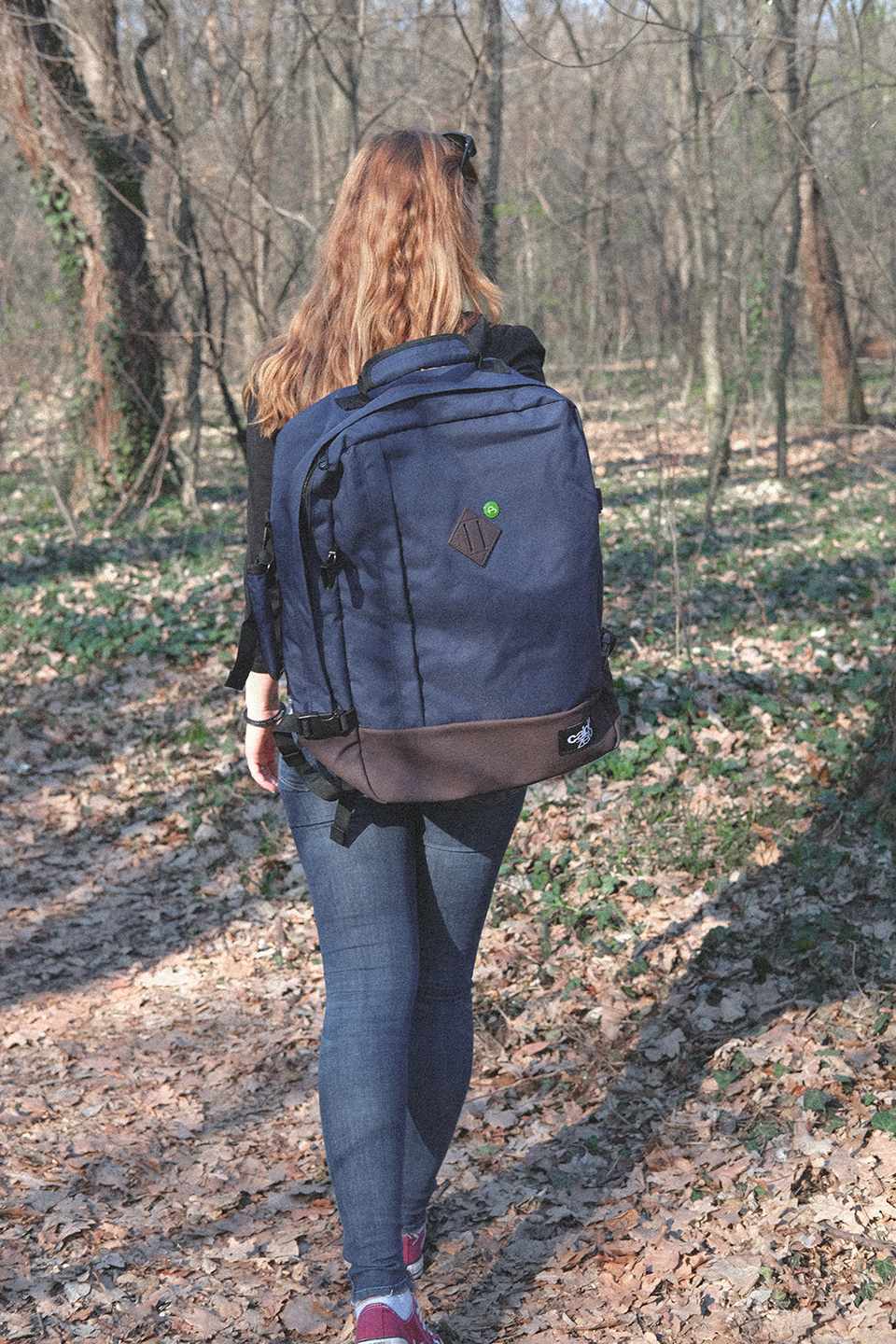
If you are a budget traveller who doesn’t want to pay for checked-in luggage, a large cabin suitcase will be perfect. Make sure you check with the airline that your suitcase size fits the allowed carry-on sizes and weight allowance.
Remember, that nowadays some airlines ask you to check in your luggage if you didn’t purchase priority boarding.
It’s always a good idea to keep a small handbag or a carry-on backpack with you which fits under the seat, so you can quickly remove valuables from your larger luggage.
Couples Trip & City Breaks

If you are going away for a quick city break or doing a multi-city hop for a few days (so jealous!) a medium suitcase should be enough. You can check it in or (in most cases) carry it on board.
A medium suitcase will usually fit clothes and accessories for two people for 2-4 days.
Need more space for gadgets and clothes? Pick a size larger suitcase and relax. You should always go for the four-wheel versions, as they are much easier to roll around.
Pro Tip: See if packing cubes can be a good fit for you. They are great to organize your clothes, inexpensive and will make your life much easier.
Holidays (up to 2 weeks)
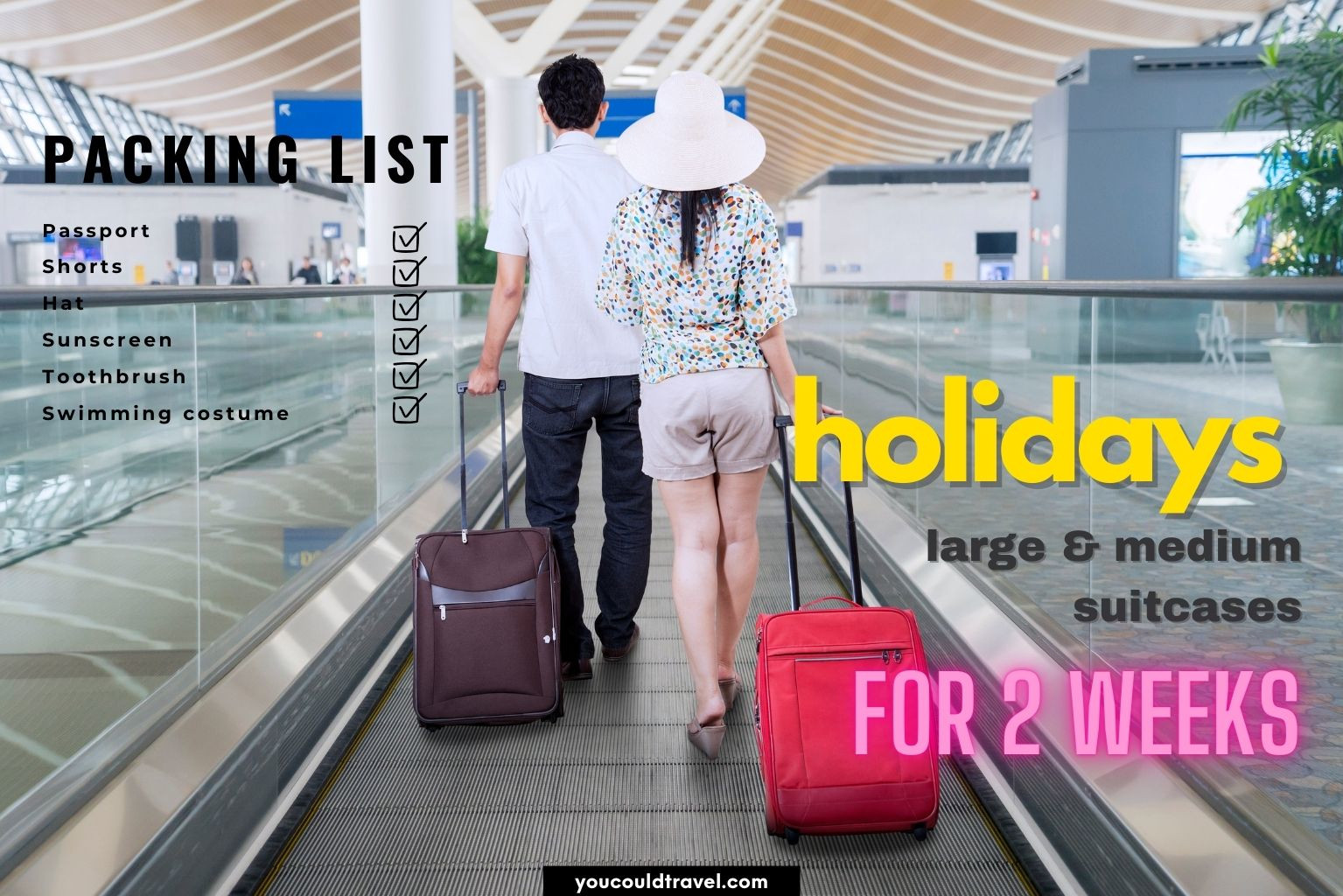
Travelling for up to 2 weeks? I would recommend one medium-sized suitcase per person (unless you are going to the beach or to a very hot destination, in which case you really don’t need much space).
If this is your first time purchasing suitcases, consider buying a suitcase set so you get better value for your money.
For your convenience, check-in all your luggage and keep just a small bag with you for your papers and valuables. This small bag should fit under the seat in front of you.
Long-term Travels & Couples
The medium or large suitcase is for long-term travellers or couples who want to minimize the checked-in costs. When you travel with someone, both of you have a carry-on bag to take on board and a checked bag each, so you have a lot of space to play with.
It’s always better to travel light, but I understand that you need a lot of stuff when you travel long term. Remember to always check the size and weight allowances with your airline before you travel.
The extra-large suitcases are perfect for long-term travellers who spend a lot of time in one destination, or for expats moving countries. Airlines normally allow you to purchase additional checked bags if needed.
Families Travelling with children

I recommend the medium or large suitcase sizes for families with children. Purchase the four-wheel version so you can carry your suitcases around much easier.
Consider investing in a suitcase set, so you get better value for your money.
Don’t forget to plan ahead. Make sure to pack everything you need onboard into a separate carry-on. Are you travelling long-haul? Consider taking food, water, medicine, toys for the kids, personal hygiene items with you.
Check with the airline to ensure, your carry-on is within the allowed size and weight limits.
It is a good idea to organize an airport shuttle to and from your hotel. This way, you will have to worry less about your luggage and enjoy more of your stay. Did you take out travel insurance?
Suitcases or bags for Digital Nomads
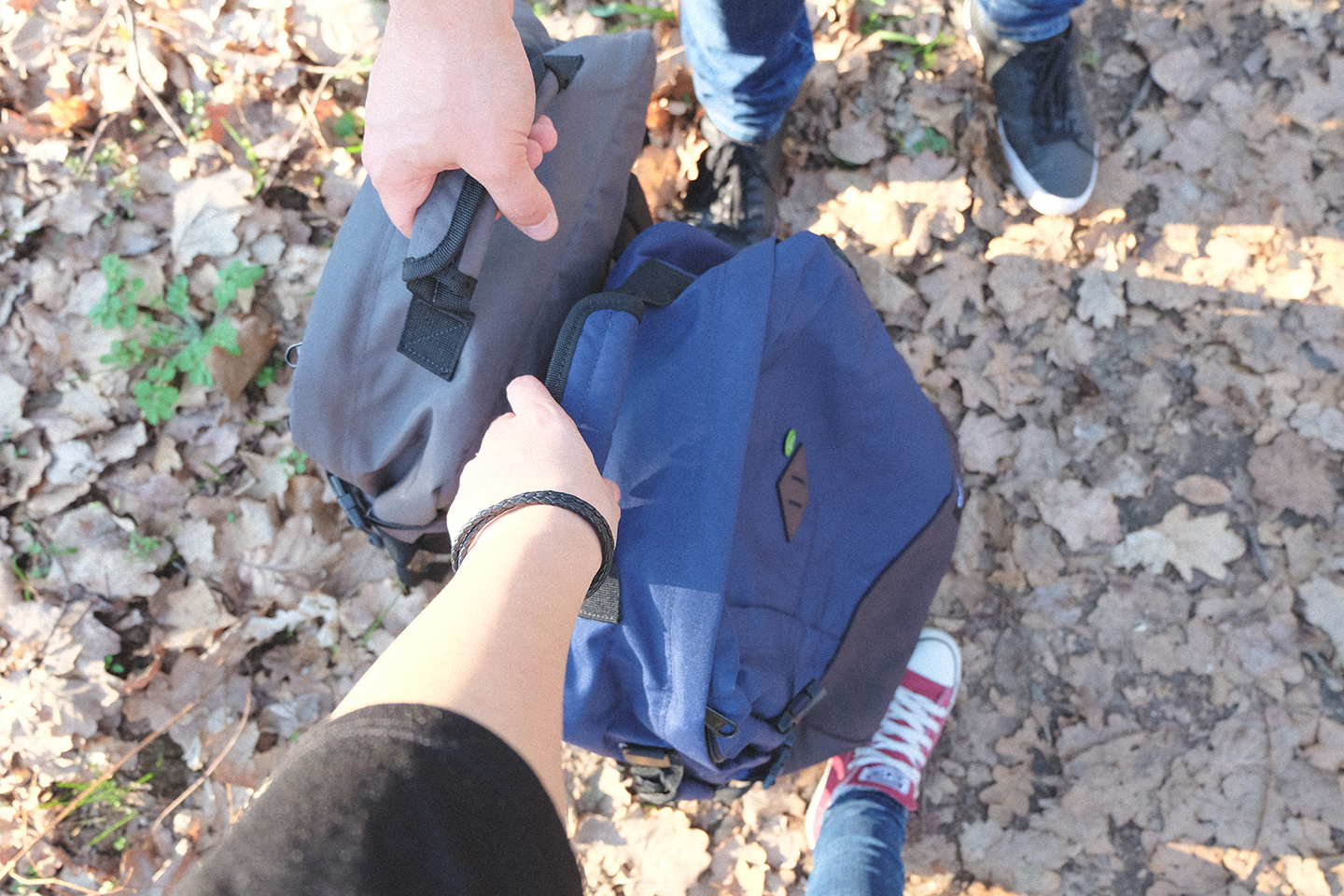
Depending on how often you change locations, a medium, or large checked luggage and a smaller carry-on suitcase or backpack should be enough.
Make sure to put your laptop, electronics, and batteries into your carry-on. It is never recommended to put valuables into checked-in luggage. Did you take out travel insurance?
As a digital nomad, you should travel light. If you move a lot, you will soon become an expert in packing and unpacking. Packing cubes can help you keep your stuff well-organized and easy to access.
If you are on a budget, consider buying a medium/large backpack. It is super convenient and easier to get around with it.
Carry-ons for Business Travellers
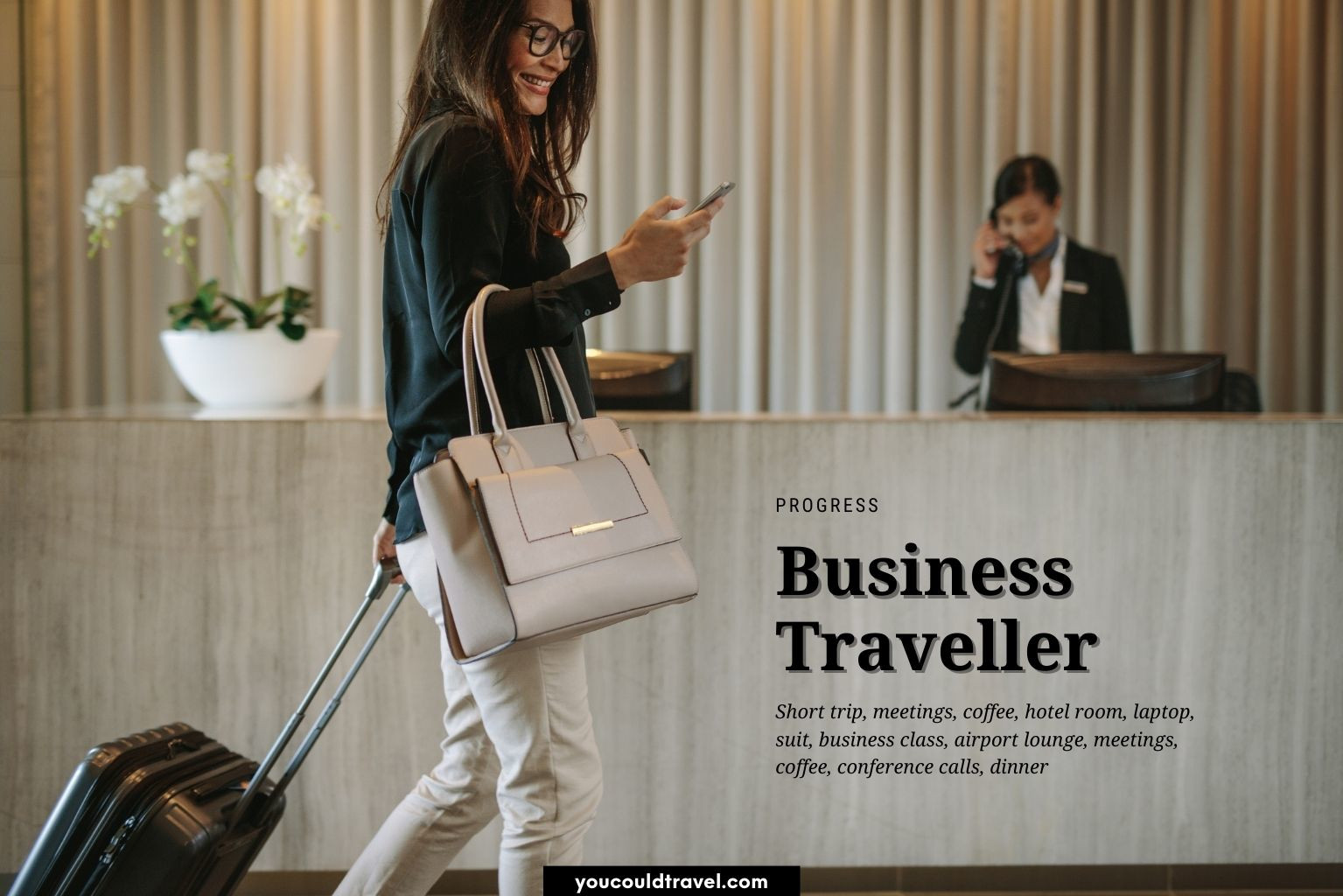
If you are a business traveller going on very short trips, then a small or medium-sized cabin suitcase with a tech compartment will be perfect for you.
You should also consider an elegant travel backpack which will fit your electronics, especially if you don’t need to carry clothes with you.
If you have to have clothes with you, check if packing cubes might be a good fit for you. They allow you to organize your clothes and, when packed well, prevent unwanted creases.
Compare Carry-on Suitcase Sizes & Volumes
Ever wondered how much stuff you can actually fit in one of these carry-ons?
In this handy table, I have collected the measurements and volume of each airline-approved carry-on suitcase. Use the “Size Type” Column to find the airline list below.
| Size Type | Suitcase sizes (cm) | Suitcase sizes (inches) | Capacity (litre) | Suitcase sizes (us oz) |
|---|---|---|---|---|
| Size A | 55x35x25 cm | 21.6x 13.8×9.8 inches | 48 l | 1627 oz |
| Size B | 55x40x20 cm | 21.6×15.7×7.9 inches | 44 l | 1488 oz |
| Size C | 55x40x23 cm | 21.6×15.7×9 inches | 50.5 l | 1711 oz |
| Size D | 56x36x23 cm | 22x14x9 inches | 46.3 l | 1568 oz |
| Size E | 56x45x25 cm | 22×17.7×10 inches | 63 l | 2130 oz |
| Size F | Various other sizes | – | – | – |
Carry-on Suitcase Sizes chart for each Airline
Airline companies around the world have different requirements in terms of size and weight of your carry on luggage.
In the tables below, I have collected most major airlines and grouped them by their maximum allowed carry on size. For each airline, I added the allowed carry-on weight in kilograms and pounds.
Size A – Carry-on suitcase
Airlines listed below allow carry-ons no larger than 55x35x25 cm (21.6×13.8×9.8 inches) on board.
| Airline | Weight (kg) | Weight (pounds) | Cabin Bag Allowed |
|---|---|---|---|
| Aerolineas Argentinas | 10 | 22.05 | |
| Air Europa | 10 | 22.05 | 1 bag |
| Air France | 12 | 26.46 | 1 bag & 1 handbag |
| Alitalia | 8 | 17.64 | 1 bag |
| Algerie Airlines | 10 | 22.05 | 1 bag |
| Arik Air (Nigeria) | 12 | 26.46 | 1 bag |
| Avianca | 10 | 22.05 | 1 bag |
| Hop! | 12 | 26.46 | |
| Jet Airways | 7 | 15.43 | |
| KLM | 12 | 26.46 | |
| Mauritius Airlines | 7 | 15.43 | 1 bag & 1 handbag |
| Tam | 8 | 17.64 | |
| Xl Airways | 5 | 11.02 |
Size B – Hand luggage
Airlines listed below allow carry-ons no larger than 55x40x20 cm (21.6×15.7×7.9 inches) on board.
| Airline | Weight (kg) | Weight (pounds) | Cabin Bag Allowed |
|---|---|---|---|
| Aeroflot | 10 | 22.05 | 1 bag |
| Air Armenia | 7 | 15.43 | 1 bag |
| Air Caraïbes (Air Caraibes) | 12 | 26.46 | |
| Air China | 8 | 17.64 | 1 bag |
| Air India | 8 | 17.64 | |
| Air New Zealand | 7 | 15.43 | 1 bag & 1 handbag |
| Air Seychelles | 7 | 15.43 | 1 bag |
| Arkia | 7 | 15.43 | |
| Asiana Airlines | 10 | 22.05 | 1 bag |
| Belavia Airlines | 8 | 17.64 | 1 bag |
| Condor Flugdienst | 6 | 13.23 | |
| Corsair International | 12 | 26.46 | |
| Germania | 6 | 13.23 | |
| Korean Air | 12 | 26.46 | |
| TAP Air Portugal | 8 | 17.64 | |
| Thomas Cook | 6 | 13.23 | |
| Thomson | 5 | 11.02 | |
| TUI Fly Deutschland | 6 | 13.23 | |
| Vueling | 12 | 26.46 |
Size C – Carry-on
Airlines listed below allow carry-ons no larger than 55x40x23 cm (21.6×15.7×9 inches) on board.
| Airline | Weight (kg) | Weight (pounds) | Cabin Bag Allowed |
|---|---|---|---|
| Air Canada | 10 | 22.05 | 1 bag & 1 handbag |
| Airberlin | 8 | 17.64 | |
| Air Baltic | 8 | 17.64 | 1 bag & 1 handbag |
| Austrian Airlines | 8 | 17.64 | 1 bag |
| Azerbaijan Airlines | 10 | 22.05 | 1 bag |
| Bangladesh Airlines | 7 | 15.43 | 1 bag |
| Blue Air | 10 | 22.05 | 1 bag & 1 handbag |
| Bmi (British Midland Airways) | 12 | 26.46 | |
| Brussels Airlines | 12 | 26.46 | |
| Ethiopian Airlines | 7 | 15.43 | |
| Eurowings | 8 | 17.64 | |
| Flyniki | 8 | 17.64 | |
| LOT Polish Airlines | 8 | 17.64 | |
| Lufthansa | 8 | 17.64 | |
| Norwegian Air Shuttle | 10 | 22.05 | |
| Olympic Airlines | 8 | 17.64 | |
| Scandinavian Airlines | 8 | 17.64 | |
| Swiss International Air Lines | 8 | 17.64 | |
| Turkish Airlines | 8 | 17.64 |
Size D – hand luggage
Airlines listed below allow carry-ons no larger than 56x36x23 cm (22x14x9 inches) on board.
| Airline | Weight (kg) | Weight (pounds) | Cabin Bag Allowed |
|---|---|---|---|
| Aeromexico | 10 | 22.05 | |
| Alaska Airways | – | – | 1 bag & 1 handbag |
| AirAsia Airlines | 7 | 15.43 | 1 bag & 1 handbag |
| American Airlines | – | – | 1 bag & 1 handbag |
| American Eagle | – | – | 1 bag & 1 handbag |
| Bangkok Airways | 5 | 11.02 | 1 bag |
| Cathay Pacific | 7 | 15.43 | |
| China Airlines | 7 | 15.43 | |
| Qantas | 7 | 15.43 | |
| South African Airways | 8 | 17.64 | |
| Vietnam Airlines | 7 | 15.43 | |
| Virgin Atlantic | 10 | 22.05 |
Size E – carry on luggage
Airlines listed below allow carry-ons no larger than 56x45x25cm (22×17.7×10 inches) on board.
| Airline | Weight (kg) | Weight (pounds) | Cabin Bag Allowed |
|---|---|---|---|
| Air Astana | 8 | 17.64 | 1 bag & 1 handbag |
| Air Nostrum | 8 | 17.64 | 1 bag |
| Aegean Airlines | 8 | 17.64 | 1 bag |
| Atlasjet Airlines | 8 | 17.64 | 1 bag |
| British Airways | 23 | 50.71 | |
| Easyjet | No Limit | No Limit | |
| El Al (Israel Airlines) | 8 | 17.64 | |
| Finnair | 8 | 17.64 | |
| Iberia Airline | 10 | 22.05 | |
| Jet2 | 10 | 22.05 | |
| Thai Airways | 7 | 15.43 |
Size F – Other Sizes
Each airline listed below has a different carry-on policy. If you can’t find your airline, please let us know in the comments section below which airline you are after, and I will add it.
| Airline | Size (cm) | Size (inches) | Weight (kg) | Weight (pounds) | Cabin Bag Allowed |
|---|---|---|---|---|---|
| Aer Lingus | 55 x 40 x 24cm | 21.6 x 15.7 x 9.5 inches | 10 | 22.05 | 1 bag |
| Air Transat | 51 x 40 x 23cm | 20 x 15.7 x 9 inches | 10 | 22.05 | 1 bag & 1 handbag |
| ANA – All Nippon Airways | 55 x 40 x 25cm | 21.6 x 15.7 x 9.8 inches | 10 | 22.05 | 1 bag |
| AeroMexico Airlines | 55 x 40 x 25cm | 21.6 x 15.7 x 9.8 inches | 10 | 22.05 | 2 bags |
| Aurigny Air | 55 x 36 x 20cm | 21.6 x 14 x 7.8 inches | 10 | 22.05 | 2 bags |
| Cebu Pacific | 56 x 35 x 23cm | 22 x 13.7 x 9 inches | 7 | 15.43 | |
| Czech Airlines | 55 x 45 x 25cm | 21.6 x 17.7 x 9.8 inches | 8 | 17.64 | |
| Delta Airlines | 56 x 35 x 23cm | 22 x 13.7 x 9 inches | Check with airline | Check with airline | |
| Emirates | 55 x 38 x 20cm | 21.6 x 15 x 7.8 inches | 7 | 15.43 | |
| Etihad Airways | 50 x 40 x 21cm | 19.7 x 15.7 x 8.3 inches | 7 | 15.43 | |
| Flybe | 55 x 35 x 20cm | 21.6 x 13.7 x 7.8 inches | 10 | 22.05 | |
| Israir Airlines | 50 x 40 x 20cm | 19.7 x 15.7 x 7.8 inches | 8 | 17.64 | |
| Japan Airlines | 55 x 40 x 25cm | 21.6 x 15.7 x 9.8 inches | 10 | 22.05 | |
| LATAM Airlines (LAN Airlines) | 45 x 35 x 20cm | 17.7 x 13.7 x 7.8 inches | 8 | 17.64 | |
| Malaysia Airlines | 55 x 36 x 25cm | 21.6 x 14 x 9.8 inches | 7 | 15.43 | |
| Malta Airlines | 55 x 40 x 25cm | 21.6 x 15.7 x 9.8 inches | 10 | 22.05 | 1 bag & 1 handbag |
| Monarch | 56 x 40 x 25cm | 22 x 15.7 x 9.8 inches | 10 | 22.05 | |
| Philippine Airlines | 115cm | 45 inches | 7 | 15.43 | |
| Qatar Airways | 50 x 37 x 25cm | 19.7 x 14.6 x 9.8 inches | 7 | 15.43 | |
| Ryanair (Priority only) | 35 x 20 x 20cm | 13.7 x 7.8 x 7.8 inches | Check with airline | Check with airline | |
| Singapore Airlines | 115cm | 45 inches | 7 | 15.43 | |
| Transavia | 55 x 40 x 25cm | 21.6 x 15.7 x 9.8 inches | 10 | 22.05 | |
| Tunis Airmax | 115cm | 45 inches | 8 | 17.64 | |
| United Airlines | 56 x 35 x 22cm | 22 x 13.7 x 8.6 inches | Check with airline | Check with airline | |
| Wizz Air | 42 x 32 x 25cm | 16.5 x 12.6 x 9.8 inches | Check with airline | Check with airline |
Compare Checked-in Suitcase Sizes
Most airlines allow a checked-in suitcase to weigh between 20kg (44 pounds) to 25kg (55 pounds), but the checked-in baggage allowance varies so much that it is almost impossible to collect them all.
The absolute maximum weight of any check-in bag is 35kg for health & safety reasons. Any bag weighing more than 35 kg will be refused by the airline.
Your baggage allowance will depend on the airline, the length of your flight (short or long-haul), and occasionally the policy of the airport where you depart from.
Always check with the airline before you travel and allow yourself enough time to pack your bags before you leave.
In the below table, I have collected the different sizes, capacity and recommended travel times for each checked suitcase size.
| Suitcase Size (height) | Capacity (litre) | Recommended Travel Time |
|---|---|---|
| 20” Small Suitcase | 38 l | 1-4 days |
| 24” Medium Suitcase | 60 l | 4-7 days |
| 28” Large Suitcase | 90 l | 7-9 days |
| 30” Extra Large Suitcase | 120 l | 9-14 days |
The below image shows the sizes of different suitcases.

How much does extra baggage cost?
If you are taking extra carry-on luggage with you onboard or check an extra suitcase on the plane, you might have to pay an ‘excess baggage fee’.
The excess baggage charge can significantly vary between airlines. Excess carry on fees are normally lower than excess checked-in luggage. Also, keep an eye on potential extra fees. For example, if your extra luggage is also oversized (it’s larger than the permitted checked-in luggage size) you might need to pay additional charges on top of the excess baggage fee.
It’s best to check with the airline prior to your travel.
Tips & Trick I learnt during our travels
Always go for the four-wheel suitcases
Suitcases are normally inconvenient to carry around. Always purchase the four-wheel version of larger suitcases. These are easier to roll, and you don’t have to lift them up.
Keep an eye on the quality. If the suitcase is of bad quality, you risk the wheels being broken by the time you arrive at your destination. Check the reviews and try to go for the suitcase with the most indented wheels.
Less is more
I found that it’s sometimes better to carry one large suitcase with us instead of two or three smaller ones. However, always make sure not to overfill your suitcase and check the weight before you travel.
Make sure you are comfortable pulling and lifting the suitcase yourself.
Carry your valuables with you at all times
Unfortunately, it can happen that things disappear from your checked baggage. I recommend that you never put valuables into the bags you check-in. Keep a small bag with you and put all your papers, electronics, and valuables in there.
Hardshell vs soft case
I found that during long-haul I prefer a good, sturdy, hardshell suitcase. The hard shell will protect your items in the suitcase and won’t tear or damage during handling.
Soft cases are lighter normally and easier to carry when you go for a short trip. Wrap fragile items in t-shirts and jumpers, so they survive the trip.
Travelling with batteries & drones
Regulations on bringing batteries on board (in a carry-on or checked baggage) varies from country to country and from airport to airport. Find the USA regulations here.
Most airlines and airports require you to carry the batteries with you on board in your carry-on. The batteries will be checked during security.
Some airports might not allow you to carry drones on board in your carry-on. You will have to take any batteries out of the drone and place them in your carry-on separately.
Always check the regulations before you leave for both your origin and destination countries. If you transfer to a new flight, make sure to check the policy of the transfer airport & country too.
Your drone and batteries can be confiscated if you don’t comply with regulations.
Did I forget anything?
I constantly improve the information here. If you notice any mistakes or outdated information, please let us know in the comment section below.
Do you have any tips? Share it in the comments below, and I will add it to the article.
Frequently Asked Questions
What is the most popular suitcase size?
According to Amazon, the most popular suitcase size is 21″ tall, dimensions are 55x35x20cm (21.6×13.7×7.8 inches), 34L in capacity and weights about 2.9kg (6.3lb). This carry-on suitcase was the most commonly sold size in 2023.
What are the standard sizes for suitcases?
The standard suitcase size is 21 inches (54 cm) tall, with dimensions of 55x35x20cm (21.6×13.7×7.8 inches).
The standard size for checked luggage is 30 inches (76 cm), with dimensions of 76×52.5x30cm (30×20.6×11.8 inches).
Carry-On Suitcase:Dimensions: Typically between 18 and 22 inches (45 and 56 cm) in height, 13 to 14 inches (33 to 36 cm) in width, and 8 to 9 inches (20 to 23 cm) in depth.
Capacity: Usually around 30 to 40 liters.
Medium-Size Suitcase:Dimensions: Usually around 23 to 26 inches (58 to 66 cm) in height, 16 to 18 inches (40 to 46 cm) in width, and 9 to 11 inches (23 to 28 cm) in depth.
Capacity: Usually around 60 to 75 liters.
Large Suitcase:Dimensions: From 27 to 32 inches (68 to 81 cm) in height, 19 to 22 inches (48 to 56 cm) in width, and 10 to 12 inches (25 to 30 cm) in depth.
Capacity: Usually around 80 to 120 liters.
Data is based on best-selling stats from Amazon UK and Amazon USA. Both of these sizes are approved by most major airlines.
What are the 3 sizes of luggage?
There are three sizes of suitcase: carry-on, medium and large.
Carry-on (30-40 l)
Medium suitcase (60-75 l)
Large suitcase (100-117 l)
You take carry-ons on board with you. Medium suitcases are checked in, and are suitable for trips lasting several days to a week. Large suitcases are used for long-haul flights and are recommended for trips that last 1-2 weeks.
If you buy a luggage set, you can save money, and you will always have the right size to pick for any trip.
What is the largest suitcase you can check in on a plane?
The usual weight limit for the largest suitcase you can check in is 30 kg (66 pounds), dimensions 81x59x34 cm (31x23x14 inches). The absolute maximum weight of any check-in bag is 35 kg (77 pounds) for health & safety reasons.
Any bag weighing more than 35 kg will be refused by the airline.
What is the standard suitcase size for airlines check in?
The standard suitcase size for airline check-in can vary depending on the airline and the travel class. However, there are some general guidelines and common size restrictions that many airlines adhere to.
For most major airlines, the typical maximum dimensions for checked luggage fall within the range of 62 linear inches (158 cm) or 63 inches (158 cm) in total (sum of length, width, and height). This includes the handles, wheels, and any external pockets or protrusions. The specific weight limit may also vary, usually ranging from 50 to 70 pounds (23 to 32 kg).
Check the suitcase size requirements for many airlines, click here.
Why buy dark-coloured suitcase?
There are several reasons why someone might choose to buy a dark-coloured suitcase:
Conceals dirt and stains: Dark colours, such as black or navy, are less likely to show dirt, scuffs, and stains compared to lighter colours. This can help your suitcase maintain a cleaner appearance, even after frequent use or rough handling during travel.
Classic and timeless look: Dark-coloured suitcases often have a more sophisticated and elegant appearance. They tend to be seen as more professional and can complement a variety of travel outfits. Additionally, dark colours are less likely to go out of style compared to trendy or bright colours.
Versatile and practical: Dark-coloured suitcases are versatile and suitable for different travel scenarios. Whether you’re travelling for business or leisure, a dark-coloured suitcase can easily blend in with different environments and travel settings.
Durability: Many dark-coloured suitcases are made from materials that are resistant to scratches and wear. While the colour itself doesn’t necessarily determine the durability, dark-coloured suitcases are often designed with practicality in mind and can handle the rigors of travel more effectively.


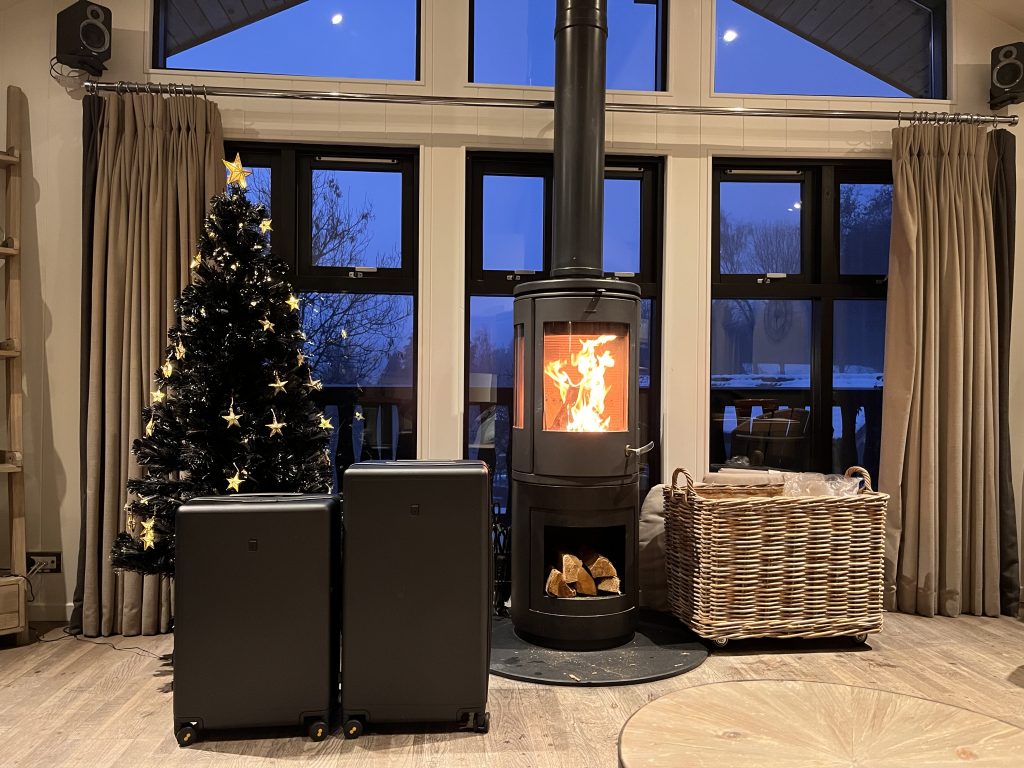

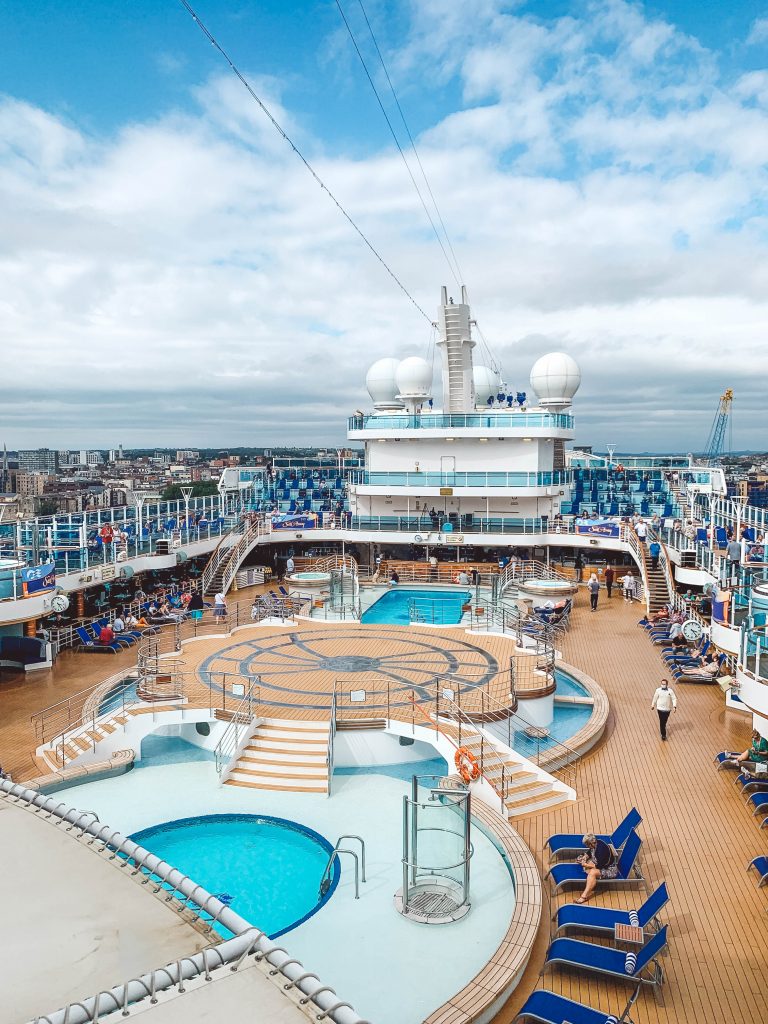




Leave a Reply